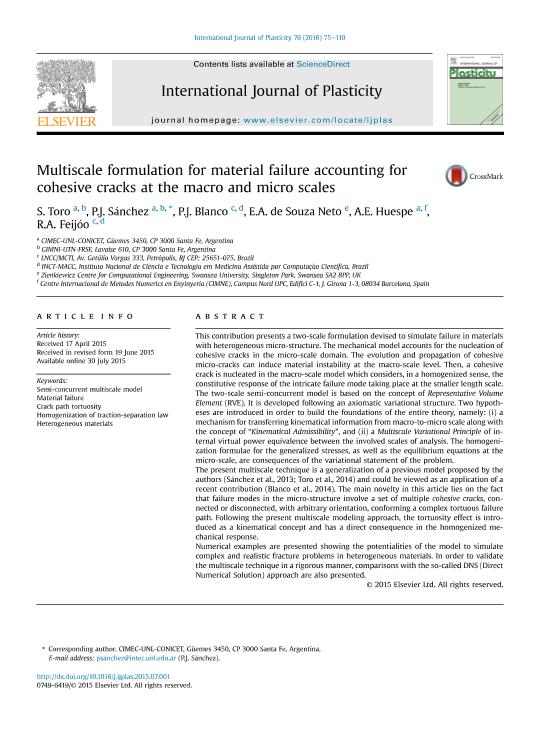Mostrar el registro sencillo del ítem
dc.contributor.author
Toro, Sebastian

dc.contributor.author
Sánchez, Pablo Javier

dc.contributor.author
Blanco, Pablo Javier

dc.contributor.author
De Souza Neto, Eduardo Alberto

dc.contributor.author
Huespe, Alfredo Edmundo

dc.contributor.author
Feijóo, Raúl Antonino

dc.date.available
2020-09-13T20:06:47Z
dc.date.issued
2016-01
dc.identifier.citation
Toro, Sebastian; Sánchez, Pablo Javier; Blanco, Pablo Javier; De Souza Neto, Eduardo Alberto; Huespe, Alfredo Edmundo; et al.; Multiscale formulation for material failure accounting for cohesive cracks at the macro and micro scales; Pergamon-Elsevier Science Ltd; International Journal of Plasticity; 76; 1-2016; 75-110
dc.identifier.issn
0749-6419
dc.identifier.uri
http://hdl.handle.net/11336/113861
dc.description.abstract
This contribution presents a two-scale formulation devised to simulate failure in materials with heterogeneous micro-structure. The mechanical model accounts for the nucleation of cohesive cracks in the micro-scale domain. The evolution and propagation of cohesive micro-cracks can induce material instability at the macro-scale level. Then, a cohesive crack is nucleated in the macro-scale model which considers, in a homogenized sense, the constitutive response of the intricate failure mode taking place at the smaller length scale.The two-scale semi-concurrent model is based on the concept of Representative Volume Element (RVE). It is developed following an axiomatic variational structure. Two hypotheses are introduced in order to build the foundations of the entire theory, namely: (i) a mechanism for transferring kinematical information from macro-to-micro scale along with the concept of ?Kinematical Admissibility?, and (ii) a Multiscale Variational Principle of internal virtual power equivalence between the involved scales of analysis. The homogenization formulae for the generalized stresses, as well as the equilibrium equations at the micro-scale, are consequences of the variational statement of the problem.The present multiscale technique is a generalization of a previous model proposed by the authors [1, 2] and could be viewed as an application of a recent contribution [3]. The main novelty in this article lies on the fact that failure modes in the micro-structure involve a set of multiple cohesive cracks, connected or disconnected, with arbitrary orientation, conforming a complex tortuous failure path. Following the present multiscale modeling approach, the tortuosity effect is introduced as a kinematical concept and has a direct consequence in the homogenized mechanical response.Numerical examples are presented showing the potentialities of the model to simulate complex and realistic fracture problems in heterogeneous materials. In order to validate the multiscale technique in a rigorous manner, comparisons with the so-called DNS (Direct Numerical Solution) approach are also presented.
dc.format
application/pdf
dc.language.iso
eng
dc.publisher
Pergamon-Elsevier Science Ltd

dc.rights
info:eu-repo/semantics/openAccess
dc.rights.uri
https://creativecommons.org/licenses/by-nc-sa/2.5/ar/
dc.subject
semi-concurrent multiscale model
dc.subject
material failure
dc.subject
crack path tortuosity
dc.subject
homogenization of traction-separation law
dc.subject
heterogeneous materials
dc.subject.classification
Ingeniería de los Materiales

dc.subject.classification
Ingeniería de los Materiales

dc.subject.classification
INGENIERÍAS Y TECNOLOGÍAS

dc.subject.classification
Ciencias de la Computación

dc.subject.classification
Ciencias de la Computación e Información

dc.subject.classification
CIENCIAS NATURALES Y EXACTAS

dc.title
Multiscale formulation for material failure accounting for cohesive cracks at the macro and micro scales
dc.type
info:eu-repo/semantics/article
dc.type
info:ar-repo/semantics/artículo
dc.type
info:eu-repo/semantics/publishedVersion
dc.date.updated
2020-09-03T19:20:45Z
dc.journal.volume
76
dc.journal.pagination
75-110
dc.journal.pais
Estados Unidos

dc.journal.ciudad
Amsterdam
dc.description.fil
Fil: Toro, Sebastian. Consejo Nacional de Investigaciones Científicas y Técnicas. Centro Científico Tecnológico Conicet - Santa Fe. Centro de Investigaciones en Métodos Computacionales. Universidad Nacional del Litoral. Centro de Investigaciones en Métodos Computacionales; Argentina
dc.description.fil
Fil: Sánchez, Pablo Javier. Consejo Nacional de Investigaciones Científicas y Técnicas. Centro Científico Tecnológico Conicet - Santa Fe. Centro de Investigaciones en Métodos Computacionales. Universidad Nacional del Litoral. Centro de Investigaciones en Métodos Computacionales; Argentina
dc.description.fil
Fil: Blanco, Pablo Javier. Laboratorio Nacional de Computacao Cientifica; Brasil
dc.description.fil
Fil: De Souza Neto, Eduardo Alberto. Zienkiewicz Centre For Computational Engineering; Reino Unido
dc.description.fil
Fil: Huespe, Alfredo Edmundo. Consejo Nacional de Investigaciones Científicas y Técnicas. Centro Científico Tecnológico Conicet - Santa Fe. Centro de Investigaciones en Métodos Computacionales. Universidad Nacional del Litoral. Centro de Investigaciones en Métodos Computacionales; Argentina
dc.description.fil
Fil: Feijóo, Raúl Antonino. Laboratorio Nacional de Computacao Cientifica; Brasil
dc.journal.title
International Journal of Plasticity

dc.relation.alternativeid
info:eu-repo/semantics/altIdentifier/url/http://www.sciencedirect.com/science/article/pii/S0749641915001199
dc.relation.alternativeid
info:eu-repo/semantics/altIdentifier/doi/http://dx.doi.org/10.1016/j.ijplas.2015.07.001
Archivos asociados
